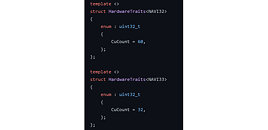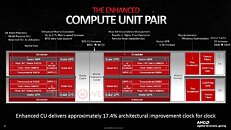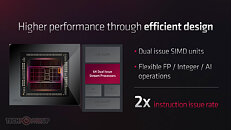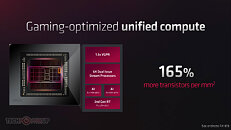- Joined
- Oct 9, 2007
- Messages
- 47,633 (7.44/day)
- Location
- Dublin, Ireland
| System Name | RBMK-1000 |
|---|---|
| Processor | AMD Ryzen 7 5700G |
| Motherboard | Gigabyte B550 AORUS Elite V2 |
| Cooling | DeepCool Gammax L240 V2 |
| Memory | 2x 16GB DDR4-3200 |
| Video Card(s) | Galax RTX 4070 Ti EX |
| Storage | Samsung 990 1TB |
| Display(s) | BenQ 1440p 60 Hz 27-inch |
| Case | Corsair Carbide 100R |
| Audio Device(s) | ASUS SupremeFX S1220A |
| Power Supply | Cooler Master MWE Gold 650W |
| Mouse | ASUS ROG Strix Impact |
| Keyboard | Gamdias Hermes E2 |
| Software | Windows 11 Pro |
The unified shader (stream processor) counts of AMD's upcoming second- and third-largest GPUs based on the RDNA3 graphics architecture, have been leaked in some ROCm code, discovered by Kepler_L2 on Twitter. The "performance.hpp" file references "Navi 32" with a compute unit count of 60, and the "Navi 33" with 32 compute units. We know from the "Navi 31" specifications that an RDNA3 compute unit still amounts to 64 stream processors (although with significant IPC uplifts over the RDNA2 stream processor due to dual-instruction issue-rate).
60 compute units would give the "Navi 32" silicon a stream processor count of 3,840, a 50% numerical increase over the 2,560 of its predecessor, the "Navi 22," powering graphics cards such as the Radeon RX 6750 XT. Meanwhile, the 32 CU count of the "Navi 33" amounts to 2,048 stream processors, which is numerically unchanged from that of the "Navi 23" powering the RX 6650 XT. The new RDNA3 compute unit has significant changes over RDNA2, besides the dual-issue stream processors—it gets second-generation Ray Accelerators, and two AI accelerators for matrix-multiplication.




No other specs of the "Navi 32" and "Navi 33" are known at this point. If AMD is sticking with the chiplet design for the "Navi 32," it could feature a similar design to the "Navi 31," with a 5 nm GCD that has these 60 RDNA3 compute units; and either three or four 6 nm MCDs, depending on whether AMD decides to give it a 192-bit or 256-bit wide GDDR6 memory interface. It remains to be seen if the chiplet design carries on to even the smaller GPUs such as the "Navi 33." There's also no word on when AMD launches the rest of its Radeon RX 7000-series graphics card lineup. The RX 7900 series sees a December 2022 debut.
View at TechPowerUp Main Site | Source
60 compute units would give the "Navi 32" silicon a stream processor count of 3,840, a 50% numerical increase over the 2,560 of its predecessor, the "Navi 22," powering graphics cards such as the Radeon RX 6750 XT. Meanwhile, the 32 CU count of the "Navi 33" amounts to 2,048 stream processors, which is numerically unchanged from that of the "Navi 23" powering the RX 6650 XT. The new RDNA3 compute unit has significant changes over RDNA2, besides the dual-issue stream processors—it gets second-generation Ray Accelerators, and two AI accelerators for matrix-multiplication.




No other specs of the "Navi 32" and "Navi 33" are known at this point. If AMD is sticking with the chiplet design for the "Navi 32," it could feature a similar design to the "Navi 31," with a 5 nm GCD that has these 60 RDNA3 compute units; and either three or four 6 nm MCDs, depending on whether AMD decides to give it a 192-bit or 256-bit wide GDDR6 memory interface. It remains to be seen if the chiplet design carries on to even the smaller GPUs such as the "Navi 33." There's also no word on when AMD launches the rest of its Radeon RX 7000-series graphics card lineup. The RX 7900 series sees a December 2022 debut.
View at TechPowerUp Main Site | Source





